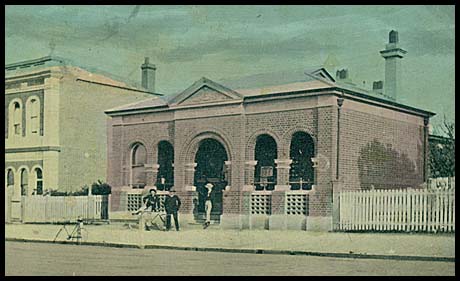Telegraph Offices in the North Central region.
- Australia 1901-1988
- New South Wales
- Overview of NSW
- Telegraph lines
- Telegraph Offices
- Date stamps
- Forms
- Envelopes
- Instructional annotation
- Collect
- Delayed
- Free
- Immediate Urgent
- Reply paid
- Rates
- Stamps
- 1871 Telegraph stamps
- 1885 proposal
- 1893 proposal
- Queensland
- South Australia
- Tasmania
- Victoria
- Western Australia
- International
- Special aspects
The Telegraph Offices constructed in the North Central region of NSW are listed in the table below:
See Revenue by station and No of messages.
|
One of the mysterious Offices along the NSW-Queensland border. After the establishment of a Post Office at Enngonia on 1 March 1871, it was decided to extend the mail run to Millens' Hotel at Boundary Lagoon. That run did not commence unti1 September 1875 by which time Boundary Lagoon was known as Barringun. |
|
Tenders were called in the November Gazette for contractors to construct a Post and Telegraph Office at Barraba - closing 22 November. |
| Bingara.
A Telegraph Office was opened at a temporary location in Bingeerera on 20 July 1875 and it merged with the Post Office on 10 August 1876. In the Legislative Assembly on 21 February 1878, Mr Burns, in answer to a question from Mr. Dangar, replied that "tenders for a new Post and Telegraph Office at Bingara would be invited as soon as possible ... The Bingara site was at the corner of Finch and Maitland Streets, opposite the Court House". "As soon as possible" meant that on 7 August 1878, The Gazette advertised for tenders to erect a Post and Telegraph Office at Bingera. |
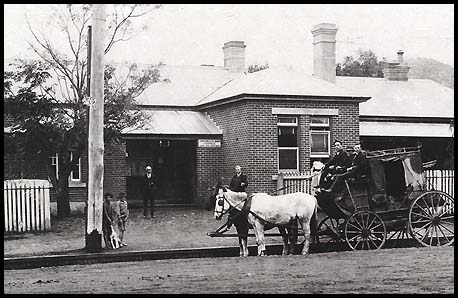 |
|
The first Post Office had been opened on 1 January 1853 but it was removed to and renamed Bingera Township on 8 July 1862. Upper Bingera opened on the original site on the same date. On 21 April 1890, the name was officially changed to Bingara. Gold was discovered in 1852 and, in the 1880s, copper and diamonds were also discovered. Not only was Bingara one of the few places in Australia where diamonds were discovered, in 1880s, Bingara produced the largest quantities of diamonds in Australia. The Evening News of 3 April 1873 provided a good description of the mining in and around Bingera and the implications for a guarantee for the Telegraph Office which included: "Now that this district is so rapidly rising into importance, and only two postal communications from Sydney per week, the want of telegraphic communication, particularly with the metropolis, is much felt by business men. The expense to "the powers that be" would not amount to much. Tarely, than, if the squatters, selectors, mining managers, hotel keepers, tradesmen,etc., have at heart the interest of the place, they will try again to raise amongst them the very trifling sum required by Government as guarantee against, loss upon any outlay they might make for a prescribed time. Why, the messages in one month would release their guarantee, i.e. as soon as it was generally known the wires were thrown open". Personnel: June 1875: Mr. Joseph Coleman was appointed Station Master. |
||
|
In the Supplementary Estimates for 1879, £1,000 was allocated for the construction of a Post & Telegraph Office at Boggabri. In the Legislative Assembly of 16 April 1880, Sir Henry Parkes informed Mr. Bennett that the plans for the new Post and Telegraph office at Boggabri were now ready and tenders would shortly be invited for the work. The Gazette of 5 November 1874 announced that Mr. John T. Tierney was appointed as Junior Operator at Boggabri in place of Mr. Chapman. |
|
The Telegraph Office was opened on 2 August 1873. Unfortunately it burnt down in November 1874 (see below). The Gazette of 22 November 1878 announced acceptance of the tender submitted by E. Hessler for the erection of a Post and Telegraph Office at Bourke. A Post Office had opened in Bourke on 22 July 1862. The Telegraph Office was combined with the Post Office on 18 July 1879. |
|
|
|
No special Telegraph date stamp was issued to the Office in Bourke. Instead the usual postal date stamp was used for telegrams.
|
Diameter: 32 mm. Used on AA-DO-13B. |
| The Empire of 26 July 1873 noted "Whilst reading the large increase in the colony's revenue, I could but turn to the telegraph posts (near Bourke) and wonder some of the money has not been expended in perfecting the undertaking. The winds sigh and moan along the idle wires, whose termination is among gum leaves in front of Tattersall's. There is no office (at Bourke), should an operator appear; and, as to taking his implements into the post-office, it was just impossible. It is high time a building fit for such work was built. We have suffered quite long enough at the Post Office. It is simply a nuisance to go for letters, supposing you have to wait, which you very often do, for a long time. It is be summer, you stand sweltering under a blistering sun, and in winter you shiver in the cold, or curse your fate in drenching rain".
The Bourke Telegraph Office opened with great fanfare on 11 September 1873 (say) after 9:30 pm. The occasion was celebrated for days. FIRE AT BOURKE: The Central Australasian 21 November 1874 reported: "On Sunday morning, between 5 and 6 o'clock, a Servant at Tattersall's Hotel heard a crackling, like wood burning, and opened her bedroom door and saw smoke issuing from an adjoining room. She at once roused Mr. Sproule and the whole house, which was full of company and everyone set to work to put out the fire but it was too late. They soon found that nothing could save the wood cottage adjoining the brick house, which was subsequently entirely destroyed; and they had the greatest difficulty in saving the brick house, which caught fire several times. The wind, which was blowing onto the brick house, veered round towards the back of the Telegraph Office, otherwise perhaps the brick house would also have been lost. As it was, the kitchen of the Telegraph Office caught fire and then extended to the Telegraph Office which was totally destroyed. Mr. Wallace's house also caught fire, and Mr. Becker then gave instructions to pull down Mr. O'Loughlan's place of business to save the houses beyond it but fortunately the fire did not extend so far. Mr. Trader succeeded in saving the telegraph instruments and on Monday opened a temporary office at Mr. Garot's, on the opposite side of the road". The Central Australian of 12 December 1874 reported "Last Tuesday morning about six o'clock, one of the gentlemen connected with this office witnessed rather a singular occurrence. A flock of wild pigeons, which came across the river flying in a body, came in contact with the telegraph wire with considerable force causing a perfect shower of feathers to fly from them. Two birds were so injured that they fell to the ground and were captured - one by the gentlemen referred to and the other by a dog. The latter was, however, quickly dispossessed of his prize. The birds were so much injured that they died shortly after. We have heard accounts of birds being killed by the telegraph and were under the impression that the electric current had something to do with it. But last Tuesday's experience proves it to be a rougher sort of shock". On 19 August 1876 (nearly two years after the fire) The Australian Town and Country Journal reported "On the supplementary estimates, I am informed, a large sum of money has passed for the building of a Post and Telegraph office at Bourke and it's nearly time, for since the late telegraph office was burnt down, the office has been carried on in a kitchen used by the commissioner and quite inadequate for the requirements of the public and a disgrace to a town of the size and importance of Bourke. I trust this may catch Mr. Burns's eye; if it does, I am sure that gentleman will take the necessary steps to remedy this evil by having tenders called for erecting the office as speedily as possible". After another 18 months, tenders were called in March 1878 for the erection of a Post and Telegraph Office at Bourke. Very soon after - in November 1878 - a tender was accepted from Mr. E. Heseler. A massive flood swept down the Darling River in April 1890. Warning telegrams were sent from Queensland warning of the volume and speed of the water coming which would completely flood Bourke (see, for example, the Capricornian 19 April 1890, p. 25). By the end of April, the water level was starting to fall. Adolph's stores in Mitchell Street, one of the oldest brick buildings in Bourke, had fallen over with a great crash. Fortunately no one was injured. Other buildings were tottering. Two buildings next the Telegraph Office had also collapsed. Personnel: September 1873: Mr. Thomas Trader was the Telegraph Station Master who assisted Mr. Cracknell to open the Bourke Office. He had been transferred from Wagga Wagga. 6 June 1879: Mr. T. A. Murray, the present junior operator at Hay, was transferred to be Operator at Bourke. May 1881: Mr. A. J. Hoskisson, a Junior Operator at Bathurst, was promoted to an Operator at Bourke to replace Mr. Young. January 1889: Mr. William Harding, a Postal Assistant at Bourke, was promoted to be a Telegraph Operator at Deniliquin to replace Mr. Cochrane. September 1892: Mr. A. Muir was transferred as Post and Telegraph Master to Wanaaring.
|
|
|
A Telegraph Office was opened at the Bourke Railway Station on 14 September 1894. It was closed in 1900. |
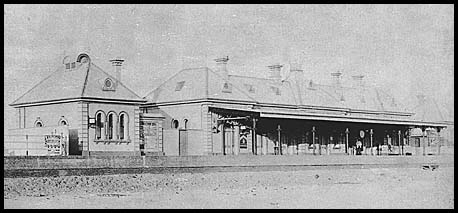 Bourke Railway Station about 1894. |
| Bundarra.
The Telegraph Office was opened on 1 October 1874. The Post Office had been opened on 1 January 1852 - well before the Office at Inverell had been opened. In 1934, an example of a Bundarra Post Office date stamp of 1857 was discovered in a deceased estate. It had been made of brass. |
Early usage: The earliest indication of the operation of the Bundarra Telegraph Office is a TELEGRAM IMMEDIATE delivery envelope (NC-EO-4) used for a message from Bundarra to Tingha on 28 August 1878. |
The Sydney Morning Herald of 10 March 1881 noted, as part of a general description of Cobar:
"At present the public buildings of Cobar are very poor in appearance and very meagre and insufficient in accommodation. The Post Office is a hut of almost the meanest description and the Postmaster is paid a salary of £50 a year. Until a short time back, he received a much smaller salary and then, as now, he had to pay the rent of the building in which the postal business of the town was carried on or use for the purpose some building of his own. There is no Telegraph Office for, important as the mining industry carried on at Cobar may be, it is only lately that anything has been done to extend the benefits of telegraph communication to the town. The contractors, who are running the wire from Louth to Cobar are still several miles distant from the point where their contract will be completed. The lockup and Courthouse or Court of Petty Sessions, have been in a very queer place indeed. The building is an ordinary wooden cottage and the room in which the court business has been transacted is of such small dimensions that magistrates, lawyers, witnesses, prisoner, police and the public must have crowded the place most inconveniently. The cells are worse. They are to be found in the back rooms of the cottage where the walls are formed of logs with such wide spaces between them that ventilation is almost as complete as in the open air and when the custody of the prisoners is so insecure that staples and rings have been placed on the floor so that men detained in the cells for any offence may be chained, in order to prevent them from escaping. I was told of one instance in which two men arrested for robbery were chained in this way for three weeks and of another case in which a drunken and riotous woman could not be taken into custody by the police because the lockup cells were full and there was no place in which to keep her". The Sydney Mail of 21 May 1881 reported news that the telegraph line from Louth had been completed (possibly in April). The article went on as follows: "The Central Australian's special correspondent writes from Cobar a rather humorous letter, decrying the site selected for the Telegraph Office, which, it appears, is not situated near the business part of the town. The letter mentions a four horse coach having been run between Cobar and the Telegraph Office, alludes to the affecting parting of the passengers with their friends, the perilous journey and the want of refreshments at the end of it; the arrival in town again without serious accident, etc. Now this is all very well in its way, but if the office is really in an inconvenient position and so many sites be available as are said to be, why not forward a petition to the proper authorities, who would no doubt inquire into it and, if required, make the necessary alteration". To provide a context of Cobar in 1881, the Sydney Mail provided the following on 13 August 1881: "Cobar is one of the few unpretentious townships in New SouthWales which can boast of the two important industries — namely pastoral and mineral. It is said that the store trade for the place is an enormous one and I was informed that the Customs have collected in Cobar alone, for the half year ending 30th June, for goods forwarded in bond, the sum of £2926 6s. 3d. The buildings for the most part are long and rambling looking, and seem to have been constructed more with a view to convenience than for the sake of appearance. They comprise some half-dozen stores, eight hotels, court-house, one bank, post and telegraph office, coffee palace and reading-room combined; three places of public worship, namely — the Church of England, Roman Catholic and Wesleyan - and numerous private buildings. The arrival of the down-country mail is a busy day in Cobar and the heavy parcels of metropolitan weeklies are speedily taken by Messrs. S. E. Collow and C. Luff, respectively agents for the Sydney Mail, and delivered within a radius of 20 miles round Cobar". The two Offices merged six months later on 28 October 1881 - a month before a fire, which started in the Metropolitan Hotel, and destroyed "a considerable portion of the town". Soon after, the Sydney Mail of 19 November 1891 commented on the day-to-day activities of communication facilities: "While talking of mails, I may as well say that we have a letter-carrier here, who is supported by private subscription, but of course he delivers letters to his subscribers only. I think it would be a good idea to get the Government to subsidise him to a certain extent, so as to enable him to deliver letters all over the town. Many of the miners, whose time is valuable to them, would be thankful for it, and the wives and families of those who are married would also be very grateful for such a boon as it would keep the husband and father out of the way of temptations to drink and gamble, which are so numerous in Cobar. The Post Office has been removed from the old shanty which has borne that dignified title for such a long time to the more centrally situated and convenient building in which the Telegraph Office has been located. The two offices are now under the management of Mr. Kenane - a gentleman who seems to thoroughly understand his duties and to discharge them with the evident desire of giving satisfaction to everybody". |
The Office was issued with a TELEGRAPHS date stamp (RC1-T):
|
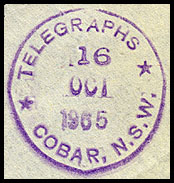 16 October 1965. Used on AA-TO-13D (ERD). Date stamp has been pushed out of its circular shape. |
| The usual postal date stamp was also used at Cobar on telegrams.
Type 2C date stamp |
|
| Condobolin.
The Telegraph Office was opened in 1878 and merged with the Post Office on 21 August 1878. The Post Office had opened on 1 July 1858. Condobolin is 467 km from Sydney.
|
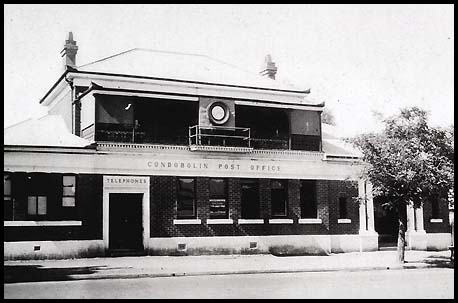 |
||
A rubber circular TELEGRAPH OFFICE date stamp was issued to Condobolin.
|
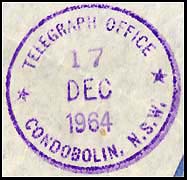 17 December 1964. Used on AA-DO-13B. |
|
|
|
The Maitland Mercury of 31 July 1873 noted about the people of Coolah: "The people of this neighbourhood are at last making an earnest effort to secure the erection of a bridge over the Coolaburragondi Creek and it is quite time they did. So little has ever been done for them by the Government, without - as in the case of the Telegraph Office - they guarantee to pay the cost themselves". The Telegraph Office opened on 17 April 1872. Personnel: April 1872: Mr. F. J.Fowler to be Junior Operator at Coolah. May 1875: Mr. Fowler, the Post and Telegraph Master was moved to Coonabarabran. Mr King replaced Mr. Fowler. |
| Coonabarabran.
The Telegraph Office was opened on 1 May 1875 as a P&T office. The Post Office had opened on 1 January 1850. In May 1878, the Government accepted the tender submitted by Mr. A. McLean for the erection of a Post and Telegraph Office at Coonabarabran. Personnel: May 1875: Mr. Fowler was appointed the Post and Telegraph Master on his removal from Coolah. 3 January 1883: Mr. T. Palmer, Telegraph Messenger, was transferred from Coonabarabran to Piliga as Operator. 12 January 1884: Mr. Ballard, Post and Telegraph master at Coonabarabran, drew Coriolanus in Tattersall's Sweep for the New Year's Cup, and was entitled to receive £900. |
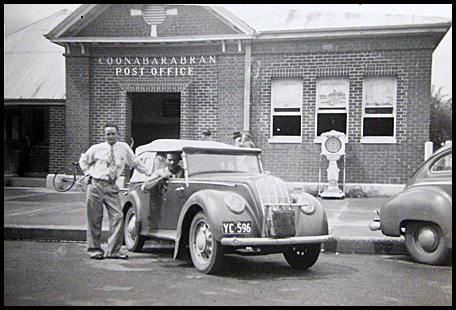 Coonabarabran Post & Telegraph Office about 1950. |
|
Earliest recorded use of the Coonabarabran Telegraph Office are:
|
||
| Coonamble.
The Coonamble Telegraph Office was opened on 10 August 1875 and merged with the Post Office on 1 September 1875. The Post Office had opened on 1 April 1859.
|
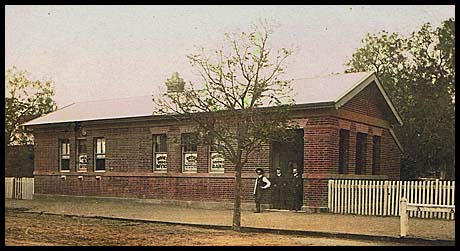 Coonamble P&T office about 1880. |
Tenders were called in April 1979 for the construction of a new Post & Telegraph Office. Clearly the Maitland Mercury (29 June 1879) considered there was a need for a new office:
In February 1881, the Post & Telegraph Office moved into its new building "although no fence had yet been erected between the Post Office yard and the gaol". Personnel: July 1876: Mr. Charles of Fry, Telegraph Master at Coonamble exchanged positions with Mr. Thomas H. Ryan Telegraph Master at Dungog. October 1885, Mr. W. H. Datson, the telegraph messenger at Girilambone, was appointed to be the telegraph operator at Coonamble. |
|
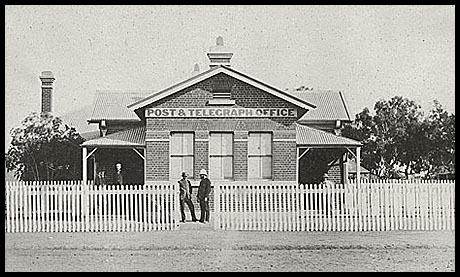 The new Coonamble P&T office in 1884. Source: NSW State Records. |
Source: NSW State Records. |
A steel circular Type 2C TELEGRAPHS COONAMBLE date stamp was used both on telegrams and on ordinary mail.
|
|
 Cover with a Coonamble Telegraphs date stamp of 28 May 1936. The cover commemorates the first air mail flight between Coonamble and Sydney. |
|
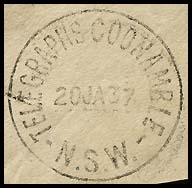 20 January 1937. |
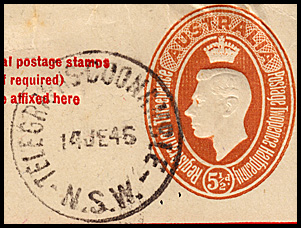 14 June 1945. Used on an embossed registration envelope. |
|
The Evening News of 6 May 1886 reported that "Arrangements are being made for holding public meetings in the Molong district to agitate for the extension of the railway to Cumnock and also for the erection of a telegraph line to that place". A Post Office had been opened in Cumnock on 1 August 1879. Alas no telegraph station but a Telephone Service at the Post Office was established on 6 February 1891. It enabled telephone and telegraph services to be transacted. For reasons now unknown - except possibly for the realisation of the greater importance of telegraphs - the Telephone Service was replaced with a Telegraph Office on 13 July 1899. |
|
Located about 20 km north-west of Armidale. The Great Northern Railway reached "Inverella" in 1884 and a Telegraph Office was opened at the Railway station. In 1885, the name "Inverella" was changed to Eversleigh but in 1889, another change was made to call the location "Dumaresq".
|
|
Personnel.
|
|
 The Dungog Post and Telegraph Office about 1910. |
|
|
A Telegraph Office opened at Enngonia on 28 March 1884. It combined with the Post Office on 1 May 1884. Prior to that, a Postal Service and later a Post Office was established at Rutherford's (Belalie Station) but there is doubt as to whether John Rutherford ever occupied Belalie Station. For more details see the well researched article elsewhere. Personnel: November 1887: Mr. Montgomery Jennings Sheppard, former Post and Telegraph Master at Marengo, was transferred to be Post and Telegraph Master at Ennogonia in lieu of Mr. Dowling. A list of the Station Masters is provided in the source cross-referenced above. |
| Gilgandra.
The Telegraph Office opened on 8 August 1882 although unofficially operational from 4 August. The Sydney Evening News of Saturday 12 August 1882 reported: "A correspondent at Gilgandra telegraphed to-day as follows: Our Telegraph Office was opened here in charge of Mr. W. H. Golding on Tuesday last under very favourable circumstances. It will prove a great boon to our flourishing district. We are greatly indebted to our energetic members, Sir P. A. Jennings and Mr Cass, for the active and attentive manner taken by them in securing such a great benefit for the district and the public in general. It will always be considered by us a pleasing recollection of our worthy and attentive members". |
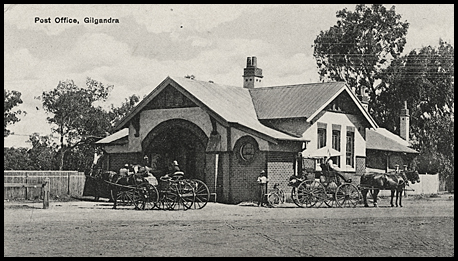 Gilgandra Post & Telegraph Office. New building constructed in the early 1900s. |
The telegraph was often used to convey important and interesting news stories. The Bathurst Times of 7 February 1913 reported:
(We don't keep stories of that caliber for over 110 years through text messages!! :-)
Personnel: March 1907: "Mr. Green, temporary assistant at the Gilgandra Post and Telegraph office, retired last week, on a pension, on account of failing health. He joined the service as a Messenger at Paddington, 28 years ago. He subsequently went to Nymagee as Operator, and thence to Broken Hill. He was then (March 1890) appointed Postmaster at Eurowie, since when he has been in charge of Oxley, Gilgandra and Mundooran. On the occasion of his departure from Mundooran recently, he was presented by the residents of that town, with a purse of sovereigns as a token of their esteem" (Mudgee Guardian 28 March 1907). |
|
A rubber circular TELEGRAPHS date stamp (RC1-T) was issued to the Office:
|
 17 May 1961. Used on AW-DO-10 (59). |
 22 October 1963. Used on AA-DO-13C. |
| Gunnedah.
The Telegraph Office opened on 7 June 1869. It was not long before there was drama:
In the Estimates of July 1877, £1,000 was allocated to the construction of a Post and Telegraph Office at Gunnedah. The Gazette of March 1878 and again of 7 August 1878 called for tenders to construct the Post and Telegraph Office at Gunnedah with closing at 11 o'clock on 3 September. In September, Mr. A. McLean was awarded the tender for the construction of the Post and Telegraph Office. Personnel: "We are glad to learn that one of our old townsmen - Mr. F. Lardner - son of Mr. Alfred Lardner, J.P., of Orange Grove, who for the last three or four years has filled the office of junior operator at the repeating station of the electric telegraph office, Tenterfield, has at last had his past services recognised, having been promoted to the office of Station Master at Gunnedah on the Fort Bourke extension line, for which district, he will leave Tenterfield during the present week" June 1876: Mr. Joshua William Nunn, Telegraph Station Master was transferred to be Station Master at Taree. |
| Inverell.
The Telegraph Office opened on 23 July 1868 and merged with the Post Office on 1 April 1869. The Post Office had first opened on 15 September 1859 when the Post Office responsibility was transferred from Byron (opened 1 January 1855) which was located 11 km away. Tenders for a new building were called in the Gazette of 5 July 1873 after £1,500 had been placed on the Estimates. |
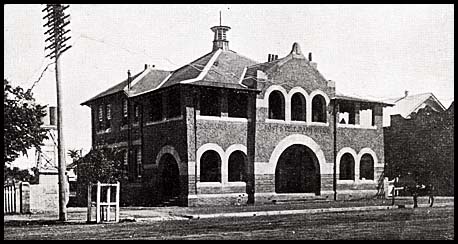 Inverell Post & Telegraph Office in 1920s. Good collectors have used this Post Office from an early age for purchasing new issue stamps and for picking up telegrams. |
|
|
||
Personnel: July 1868: John Eames was appointed as the first Electric Telegraph Master and Line Repairer; October 1879: Mrs. E. T. Eames was appointed Telegraph Mistress to replace the late John Eames. September 1882: Mr. A, Bathgate, Messenger at Quirindi, was promoted to be Operator at Inverell to replace Mr. Grovenor. March 1885: "We regret to have to record that Mr. Bathgate, Telegraph Operator here, has been in ill-health for some time past, a condition no doubt induced by a too-long continued close application to the duties pertaining to his official position" (Armidale Express 27 March 1885). January 1898: The assistant postmaster, Mr McArthur, who has held office in his area for the last 10 years, has now been promoted to Louth as Post and Telegraph master. He was presented last night by the citizens of the town with a purse of £30. A concert was held in the Council chambers afterwards in Mr McArthur's honour. |
||
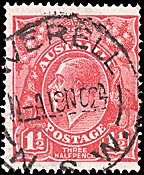 |
19 November 1924.
Usual postal date stamp with |
See similar telegraph humour on postcards elsewhere. |
| Louth.
The Louth Telegraph Office opened on 15 April 1878 and merged with the Post Office on 1 December 1880. The Louth Post Office had opened on 1 March 1869 but was closed from 30 June 1871 to 4 August 1873. Louth is 842 km from Sydney. Tenders were called for the erection of a Post & Telegraph Office at Louth in August 1879. In October, it was announced that the tender submitted by J. Dobbie had been accepted. |
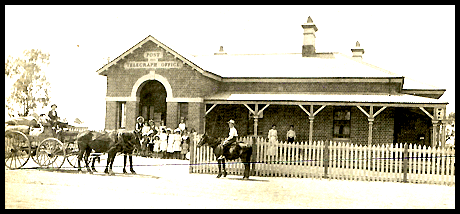 Louth Post & Telegraph Office (circa 1900). |
A view of Louth in the 1870s was published in the Freeman's Journal of 8 June 1878: GOVERNMENT NEGLECT. Sir, — From the dormant state of lethargy have the residents of Louth awakened to a sense of their wants. We have police stationed here and not before time. We have a court of Petty Sessions, but no magistrate, no Justice of the Peace, nearer than seventy miles from here. Our prisoners on trivial cases are brought to Bourke, at great inconvenience to the parties that are reluctantly compelled to go to prosecute, and at great expense to the Crown, which means the public or taxpayers of New South Wales. Crime of many sorts goes unpunished from this cause, the cost of justice. It is not an honour to the practical squatter of the neighbourhood to be appointed a Justice of the Peace, as at various times, appointments of mere boys are made to sit and adjudicate on hoary-headed men; but some of those appointments are made through inebriated recommendations, so that the common-sense man, seeing this, will not get sworn in and if he is a manager for some Nabob, he knows that his loss of time will be looked on as neglect of station duty; so that what down your way would be looked on as — and might be to many small minds — an honour, would be here a loss of time and no honour, but loss, especially in drought or shearing time. We do not want such men here. We want a resident magistrate, who would be answerable to the country for all unfair decisions. This is what the residents of Louth require; this is what they demand, not as a favour, but as a right. The state of trade, commerce, enterprise, and industry is such as to call for this step, and they have just cause for the annoyance they feel at the utter neglect and this flagrant denial of justice on the part of the Government of New South Wales. At a meeting held last night at Mathew's Louth Hotel, there was very strong language used at the manner in which the residents of this part of the Darling are treated. One speaker said, and with reason, that it seemed as if the Government wished to foster crime, from the neglect we have received. He said that the residents of Louth asked very little, and in return got less. Is it too much, said he, that we ask this liberal Government to give us a resident police magistrate? See the licenses, rents and other taxes that we pay in the country that surrounds Louth, of which it is the acknowledged centre. We are on the direct route from Melbourne to Cooper's Creek or the Gulf of Carpentaria — say in Bourke or Wilcannia as they may to the contrary. Look at the map. See the stations by which we are surrounded and their immense population :
On these stations are large numbers of working men employed. Louth is the legitimate or, as it were, the head centre of this district. It boasts of:
This is the case as it stands. You will do the residents of Louth and its surrounding district great service by lifting our cause from this Government sleep or worse than nightmare. The Australian Town and Country Journal of 12 May 1888 announced with pleasure: "Our new Post and Telegraph office, which has been recently completed, is a great, addition to our township, and reflects credit on the contractor, Mr. Dobbie. The building has been duly inspected by the Government inspector, who was much pleased with the manner in which the work was performed. The townspeople are glad to see our worthy postmaster, Mr. Pugh, in commodious quarters. The new building, which is a brick structure, will meet the requirements of Louth even should the population increase tenfold". Personnel: February 1888: "Mr. Pugh, the officer in charge of the Post and Telegraph office here, left this morning for Bourke en route for Mogil Mogil where Mrs. Pugh is lying dangerously ill. Three weeks ago last Monday Mr. Pugh received a telegram notifying him of his wife's illness. He immediately wired to the powers that be applying for leave of absence. His application was however not deemed to be of sufficient importance to merit an answer. Later on he sent another wire of the same purport, to which a reply came, but refusing the leave. Since then however it has been granted and Mr. R. K. Campbell from Cobar arrived this morning to take temporary charge. Mr. Pugh has been stationed here only three months but during that time he has gained the goodwill of all here not only by his courteous civility, but also by his being always ready to identify himself with any sports or anything for the welfare of the township" (Western Herald 15 February 1888). January 1898: Mr. McArthur, formerly Assistant Postmaster at Inverell for 10 years, was transferred to Louth to be Post and Telegraph Master. |
|
| Mudgee.
On 10 December 1861, the Legislative Assembly was informed that tenders had been called for the construction of a Telegraph Office in Mudgee. A Telegraph Office was opened on 16 May 1862 (H&T say 1861) and combined with the Post Office on 1 January 1870. The Offices were separated on 26 June 1871 but recombined on 1 April 1893. The Post Office had opened on 1 January 1840. A notable event was reported in the Illawarra Mercury of 6 March 1942 - "a boy telegram messenger could not be obtained and so the postmaster appointed, a girl". Not really that long ago. A Telegraph Office was opened at Mudgee Railway Station on 14 September 1894 and it closed in 1915. It was reopened at a date unrecorded but closed again on 31 December 1955. |
.jpg) Mudgee P&T office under construction. Source: Wikipedia. |
||
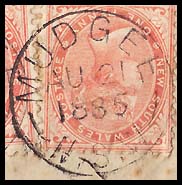 |
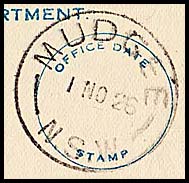 |
||
| Mudgee 21 August 1885. Date stamp type 1D (i) with side arcs and no full stop after W. Used on delivery envelope (NC-EO-3B). |
Mudgee 1 November 1926. Type 2A date stamp with side arcs and no stop after the W. (AB-DO-3D). |
||
|
A Post and Telegraph Office was opened on 13 February 1882. The Post Office had been opened on 1 January 1851. The Office changed name to Mendooran on 1 June 1918. |
| Mungindi.
The Mungindi Telegraph Office was connected to the Queensland network by 7 May 1881. The line to connect Mungindi to the NSW network opened on 28 November 1881. It is not known where but it may be inferred that it was in one of the buildings shown below. |
||
|
||
By 1862, a packhorse and a private mail service operated between Surat and Yarawa and this was extended to Mungindi. In 1865, the Queensland Postmaster General investigated the situation and accepted a recommendation to open a Post Office with Alexander Walker - the "Founder of Mungindi" - being appointed as Post Master. Walker had already established a store and hotel there and was the base for the private mail service. It was not too long before Walker faced the problems of managing a Post Office which spanned the border. He could not, for example, deal with letters which bore NSW stamps. To resolve the problems, Walker was also appointed as Post Master for New South Wales at the same office. Hence the date usually accepted for the Office opening is 1 April 1867. Alexander Walker was obviously a man with initiative. The Armidale Express of 8 August 1868, for example, reported "Notwithstanding the dry season, the proprietor of the Mungindi Hotel has a garden full of all sorts of vegetables - splendid white heart cabbage that never had a drop of rain. It shows what can be done by irrigation. He had a well sunk in the garden and the water run in covered drains between the rows". Alexander died in 1878 and his wife continued as Post Mistress and Telegraphist as well as being in charge of the hotel and the store. She was to be referred to as "The Queen of Mungindi". On 25 March 1881, the (Queensland) Gazette called for tenders to construct a Telegraph Office at Mungindi with a closing date of 29 April. On 3 May, tenders submitted by Hardy and Vowles (£745 for completion in 6 months) and from William Moody (£585 for completion in six months) were opened. BUT - on 16 July 1881, the Brisbane Courier noted that the Gazette of the same day advertised "For the erection of Post and Telegraph office at Mungindi with a closing date of 19th August". Mr. Norris was the first Telegraph Master - appointed by the Queensland Government. The Telegraph Office merged with the Post Office on 1 February 1882 with Mr. J. A. Gordon in charge. The Post Office is still in Walker Street. Mungindi is 780 km from Sydney. It is split over the border between New South Wales and Queensland. In the 2016 Census, 601 people lived in the NSW part (south of the Barwon River) while 146 lived in the Queensland part (north of the Barwon). Mungindi has a NSW postcode (Wikipedia). |
||
| The Post Office with a stage coach about 1890s. This building has elements which are similar to the second building from the left in the above image. Either the design was copied or the original building was remodelled and the larger store moved to another location. | 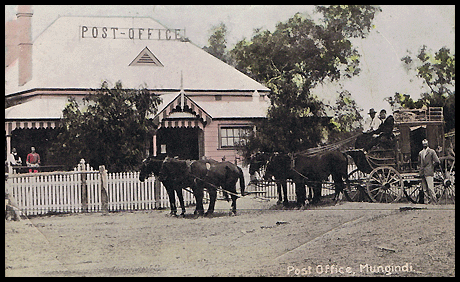 |
|
 Mungindi Post and Telegraph Office in about 1929. |
||
Being right on the NSW-Queensland border, Mungindi was singled out as an example of the problem of having special "border rates" for telegram charges. In a debate in the House of Representatives on 24 October 1935, Mr. Nock (Country Party, NSW) said that:
|
||
| Narrabri.
The Narrabri Telegraph Office was opened 8 June 1869. Mr. Ballard, messenger of the Tamworth telegraph office left on the 5th for the the Narrabri to perform the duties of acting-Station Master, until the Government appointed someone permanently. Almost immediately, Mr. R. D. Arnott was appointed.
The Maitland Mercury of 2 September 1869 commented: "The telegraph is in full operation and is quite a boon to the people now that our mails depart at such awkward times. We get our Sydney and Maitland letters on Monday and Thursday mornings and the return mail starts out again in a couple of hours which oftentimes makes it awkward to reply by return - hence the use of the telegraph". |
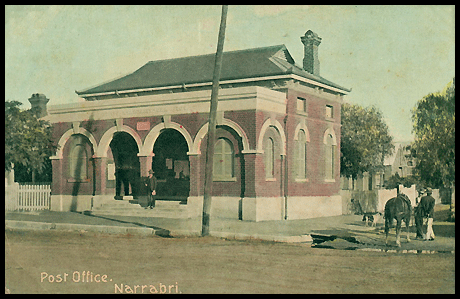 Note: this picture has been printed in reverse!! The enlargement shows the letters of "POST AND ..." on the façade are reversed. |
|
|
||
See also the image for Wee Waa. The Telegraph Office merged with the Post Office on 15 July 1872 - the Post Office having been opened on 1 June 1861. "A public meeting was held in the Court House on the 20th instant, with the view of remonstrating with the Government against the proposed amalgamation of the office of Postmaster with that of the Telegraph Station master at Narrabri". In the Gazette of March 1877, tenders were called for the erection of a Post and Telegraph Office at Narrabri - closing 17 April 1877. In the Gazette of 12 April 1877, tenders were called for the erection of a Post and Telegraph Office at Narrabri - closing 24 May 1877. For those with a keen interest in this region, the report printed in the Maitland Mercury of 29 October 1869 makes very interesting reading. Two points relevant to this description are:
Personnel: September 1882: Mr. R. W. McNab, a Messenger at Young, was promoted to Junior Operator at Narrabri. |
||
A steel circular type 2C TELEGRAPHS NARRABRI date stamp (SC1-T) was issued to the Office.
|
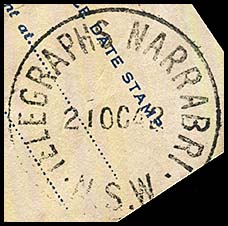 21 October 1942. Used on AB-DO-8H. |
|
| The Narrabri Railway Station also had a telegraph office from 19 February 1883 although over the following 50 years, the name kept changing - Narrabri West, Narrabri West Railway Station as well as the original Narrabri Railway Station. | ||
| Nymagee.
A Post Office was opened at Nymagee on 16 September 1880 and a Money Order Office soon after on 8 October 1880. The Telegraph Office was opened on 1 December 1881Presumably the delay was because of having to wait for the public pound to be established in March 1881. . Copper was found around Nymagee and while prices were high, the town florished. After prices plunged around the mid 1880s, the large mine was almost closed and most of the people left. In a review of the rains and conditions of the towns and districts in this region, the Sydney Morning Herald of 16 November 1881 observed "Splendid rain set in this morning at Nymagee. A great many persons from the back country are in town attending the Quarter Sessions which commence tomorrow. People from Nymagee complain greatly that, although there is a telegraph to that place and an office has been built, no operator has been sentHard to get all the ducks in a line.. They have only one mail per week and the insufficient communication seriously retards business". On 6 July, the Australian Town and Country Journal commented as follows: "I really must complain of this "public building" and don't think I am the first. It is simply a disgrace to the town, and also to the Government, to allow the telegraph and postal business to be carried on in such a despicable looking structure. People ask why don't our members see after our mails. But where are our members? Have they deserted us altogether, for nobody seems to know where they are or what they are doing. Nor are the residents themselves free from blame. It is simply an absurdity to suppose that the members of a district are going to write to their constituents to ascertain what they want doing or what they don't want. When public works are to be seen to, we must write and ask until we get them; but the way things have been of late - nobody taking any interest in any matter, whether for their own or public good - what can we expect? Why, simply to be left always out in the cold, and only ourselves to blame for being neglected". In the reference below, the following description from 1888 of the Post and Telegraph Office is included: "The most imposing building in the town is the Post Office. It is situated in a convenient position on a site presented to the Government by Mr. Roset of Hartwood Station. The room devoted to public business is 21ft long by 18ft wide; and in this there is ample accommodation at present. The only entranoe, however, is through the private portion; and this can scarcely be as convenient as might be desired. On the western side a porch is provided, in which telegrams can be written out and handed through a window; and this window is the only one for the delivery of letters and for transacting all the business, whether appertaining to the postal, telegraphic or money order and saving bank departments. This must be decidedly awkward when a great deal of business is done at the monthly pay time, for instance. In the private apartments there are two good-sized rooms. But the others are very small, owing to the numbers of angles in the rear part of the building. The Post and Telegraph Master (Mr. H. J. Burton and his wife) appear to be well satisfied with their quarters. E. F. Dalgleish is telegraph operator and J. Pascoe messenger". An excellent review/comparison between Cobar and Nymagee was published in the Australian Town and Country Journal of 19 May 1888. The Launceston Examiner of 30 April 1890 provided the following description: "Nymagee is an unpretentious-looking place composed of two streets, five hotels, a large red brick Post and Telegraph Office, several fairly sized business establishments and a collection of not very imposing private residences". No special date stamp was issued for use with telegraphs. |
|
The Telegraph Office opened on 3 September 1872. In August 1887, the Gazette notified that a render had been let to John Anderson for the erection of a Post and Telegraph Office at Pilliga. Personnel: 1872: Mr. Edward W. Bramble was appointed Junior Operator. January 1883: Mr. T.Palmer, Telegraph Messenger, had been transferred from Coonabarabran to Pilliga as Operator. May 1883: Mr. George Bragg, Messenger at Botany, had been transferred to Pilliga as an Operator to replace Mr. Hamilton.. |
|
The biggest mystery Post & Telegraph Office along the NSW-Queensland border. "Following the acceptance of a tender for a mail service between Bourke and the Warrego River in May 1866, the N.S.W. Postal Dept. decided to establish a Post Office at "Rutherford's" (Belallie). However, postal officials were uncertain as to whether Belalie Station was actually occupied by John Rutherford". Rutherford's/Belallie is situated on the Warrego River and about 100 km from Bourke and south of Cunnamulla. It was therefore about half way between Enngonia and Barringun. |
|
The Telegraph Office opened at Tingha on 14 June 1879. |
Earliest usage: The earliest evidence that the Telegraph Office was close to Tingha is a TELEGRAM IMMEDIATE delivery envelope (NC-EO-4) used for a message posted from Bundarra (see above) to Tingha on 28 August 1878 - about nine months before the Telegraph Office was opened at Tingha. |
|
A Telegraph Office was opened at Trundle Lagoon on 18 January 1892. A Post Office had been opened on 2 May 1889. These offices combined on 11 July 1892 and changed name to Trundle. Mr. S. C. Francis was the Station Master. |
|
| Walgett.
The Telegraph Office was opened on 22 September 1873. It merged with the Post Office on 1 November 1874. The Post Office had opened on 1 July 1851. |
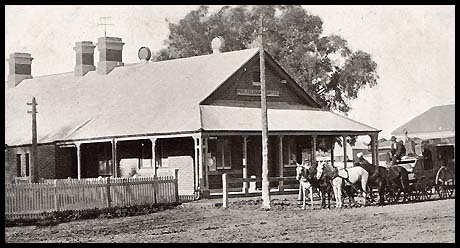 The Stage Coach outside the P&T Office in Walgett - after 1874. |
On 21 October 1873, the Mainland Mercury printed an article about Walgett. In part it noted: "The telegraph office is worked efficiently and excellently supported. The station master, Mr. Cullan, seems a courteous and an efficient officer. The office premises have been leased from Mr. Wm. Thompson, the Mungindi mail contractor, at a rental of £20 per annum. The fixings of the office wear a business-like appearance and deserving of special mention is the telegraph clock, that is now an institution at Walgett. It faces the door and the passer-by, with his "prevaricator" can regulate such to Sydney time. It arrived out of order considerably but Mr. Inspector Jones, of Narrabri, who happened to be on an official visit, put it in going order". The Gazette called for tenders to construct the Post and Telegraph Office at Walgett in January 1879 - closing 28 January. On 11 February, the tender was awarded to Mr. T. F. O'Keefe. In June 1880, the Gazette announced the granting of a tender to Mr. D. Edwards for the erection of a Post and Telegraph Office. The Sydney Mail of 27 August 1881 reported "The new post and telegraph office is slowly approaching completion, and when finished will form a convenient addition to our other Government buildings. The new courthouse premises were opened on Friday (without ceremony). This building reflects great credit both on the pait of the Colonial Architect's Department for its neat and commodious style, and on Mr. Edwards, the local contractor, whose superior workmanship ia a feature of agreeable comment to all those interested, the proof being that he holds his ground against all comers, having more private work on band than any other local contractor. I may also mention that this gentleman has this week closed for the erection of a two-story brick hotel, to be completed in seven months". On 1 July 1882, the progress made in Walgett was recorded by the Australian Town and Country Journal:: "Our Township: Walgett, although comparatively speaking unknown to the greater portion of the public of New South Wales, is a very important township, distant from Sydney some 450 miles, and situate almost at the junction of the Namoi and Barwon Rivers. It deserves more attention from the powers that be than it actually receives. It contains several large stores, branches of the Bank of New South Wales and Commercial Bank, and has now a splendid building used as a Post and Telegraph office (see above), which, with our new court house, lands office, etc, occupies the Government reserve here. There are six hotels and, as we are shortly to have a new gaol, it will be seen that, although far into the interior, we have the bump of progressiveness to a great degree". |
|
|
|
The Sydney Morning Herald of 11 November 1873 told of "very heavy thunderstorms at Walgett on, the 30th and 31st October. The telegraph wires were melted and the wall of the Telegraph Office was burnt". The Maitland Mercury of 3 August 1876 printed two articles with datelines of 25 and 28 July at Walgett which emphasise the need for high levels of technical skills in Telegraph Station Masters: 25 July: "The BrendaBrenda is just inside the NSW border about 40 kms south west of Hebel (in Queensland). The Culgoa River flows through the area. Just as the telegraph would have been our protection, it has failed. The instrument has gone wrong. The "relay" is available and, to an operator who could read by sound, could be applied. But this the present telegraph master cannot do and, although I do not intend to disparage this gentleman, who I find courteous and attentive, and have no doubt under ordiaary circumstances quite efficient - still thousands of pounds may be lost to the district through the change recently made in the operating branch of this office. As an operator by sound or otherwise, the late telegraph master (Mr. E. W. Bramble) was at the top of his business. He possessed sufficient mechanical knowledge to adjust or repair the instrument and had the confidence of this large district. He should never have been changed from this important border Station, for the special qualifications he possessed to fill the appointment of its Master, cannot be acquired except by long graduation. Judge our position - with floods and rumours of floods - with thousands of pounds worth of stock depending on correct information - with five or six boats awaiting orders to start by "wire" from South Australia - and with important commercial telegrams, appertaining to the station transfers now going on - and the office unavailable: the wire overhead like the cap of Tantalus, and us in a similar position to Tantalus himself. One hundred pounds could be raised in less than so many minutes if the wire could be repaired for the sum forthwith. We sympathise deeply with the present operator in his unenviable position. It is not his inaction we blame but we have a right to demand and to know whose mismanagement has caused this confusion which may be fraught with loss of life and property never dreamed of in the philosophy of the Sydney office". 28 July: "The Barwon continues to rise fast. It is now too wide to swim horses over. The Brenda mailman returned this morning with the out-going mail, unable to proceed. The water is over the top-rails of the paddock along the Goangra Road (Jones's ). The bridge works cannot proceed until the water subsides. Three loaded waggons came in from Wallerawang today - two for Thompson, Vaughan & Co., the other for H. Nelson & Co. The Telegraph Office is still unable to receive or despatch any business as the instruments will not work. The weather is very threatening indeed. Rain would create anxiety just now as the rivers are so high. The " wire" failing us in the hour of danger is very unfortunate". (Ed: The severe drought at Wilcannia was still continuing unabated!!!). Personnel: October 1876: Mr. Duncan A. Murchison, a probationer at Coonabarabran, was appointed Junior Telegraph Operator. January 1883: Mr. G. Goodman, a messenger at Walget, was promoted to the position of Operator. |
|
Date stamp.
|
|
| Warialda.
The Warialda Telegraph Office opened in temporary premises on 10 August 1877 and merged with the Post Office on 1 July 1877. The Warialda Post Office had opened on 1 January 1848. As of February 1878, no plans had been drawn up for the Warialda Telegraph Office because no site had been secured. A tender was accepted in January 1879 for the erection of a Post & Telegraph office in Warialda. |
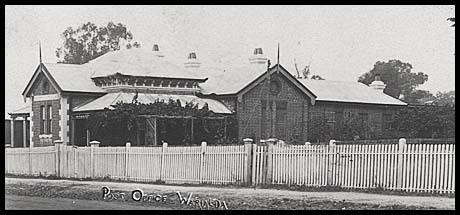 |
|
Personnel: June 1875: Mr. Lot Mannix was appointed Station Master. |
||
H&T Type 1D (i). Used on 9d Commonwealth issue |
 2 July 1905. 2 July 1905. |
|
| Wee Waa.
The Wee Waa Telegraph Office opened on 28 August 1872. Freeman's Journal reported on the local situation on 1 June 1878: "Bricks are being made for the new court-house. Mr. J. Facer is also erecting a building to be used as a Telegraph Office". On 12 September 1878 it was noted that "The new telegraph office is now completed and awaits occupancy. The court-house progresses steadily". The Wee Waa Post Office had opened on 1 January 1849 and the two offices merged on 16 July 1882. |
||
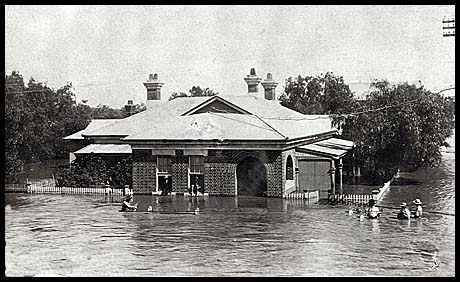
See also the image for Narrabri. |
Wee Waa Post and Telegraph Office during the major 1910 flood. The Evening News of 17 January 1910 reported on the HEAVIEST FLOOD ON RECORD. There is a record flood at Wee Waa. The Electric Telegraph Department was advised this morning by the Brewarrina office that the lagoon at Wee Waa being in flood the water swept over the banks at 3 o'clock this morning, and, spreading rapidly, the town a few hours later was inundated. A message dispatched at 8.45 this morning to Sydney stated that the town was under water. In the post office the water was three feet deep, and the flood was rising. The police were removing the residents from their out houses. The flood was stated by the postal officials to be the heaviest on record. It is expected that the mails for Walgett and other towns in the surrounding districts will be blocked by the flood. The telegraphic service is interrupted, owing to the poles being washed out, and the lines being under water". The Cootamundra Herald added "The telegraph operator sent his last message from Wee Waa at 5 p.m. He was then standing up to his waist in water". |
|
Soon after, the Maitland Mercury (27 June 1885) carried a report from a Wee Waa reader reporting on the rapid changes being made or contemplated: "At the beginning of the present year, there was a sum placed on the estimates for a new Post and Telegraph office at Wee Waa, and recently we have noticed that plans and
specifications are being prepared. I expect this time next year it will be notified that the said plans, etc, are ready and tenders will be called some time in 1887. The premises used at present for the purpose are totally unfit for the amount of work done therein ; however, we hope soon to see a comfortable and commodious building erected and then our attentive and obliging Post and Telegraph master and his assistant will die happy".
Almost on cue - on 17 May 1887 - "The new Post and Telegraph Offices will be started next week. The contractor is making preparations on the works". By 22 October 1887, the Maitland Mercury reported that "The contractor for the new Post and Telegraph Offices is progressing as favourably as can be expected with his work. Nearly time something was done". On 12 February 1888: "The new Post and Telegraph office is nearly completed. It will be a great advantage, besides an ornament to the town. Our respected postmaster will find it better than the one he is in at present". See a lovely 1887 description of Wee Waa. Personnel: 1872: Mr Edward Phelan was appointed to be Junior Telegraphic Operator. January 1883: Mr. J. T. Molloy was promoted fromOperator at Gunnedah to be Station Master at Wee Waa to replace Mr. McKellar. 1887: Mr. John Molloy was the Officer in charge of the Post and Telegraph Department. |
||

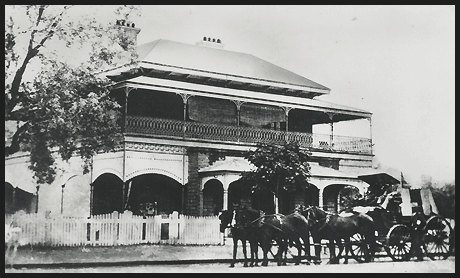
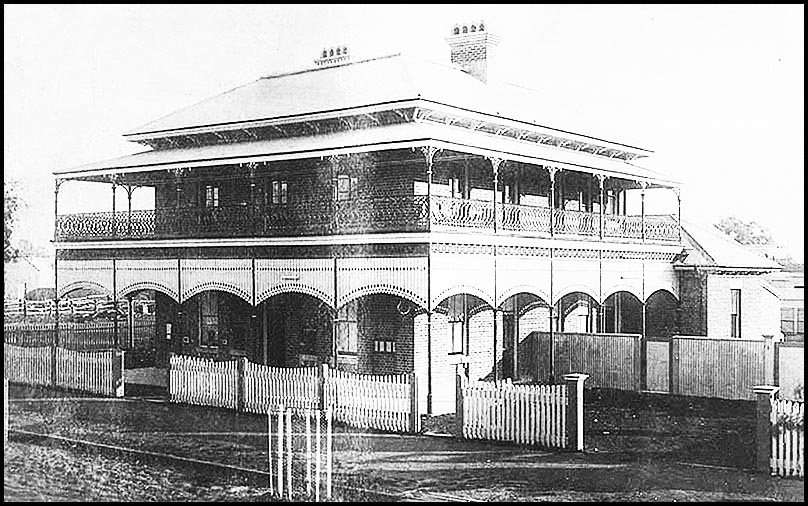
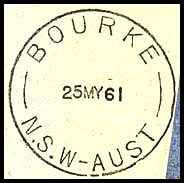

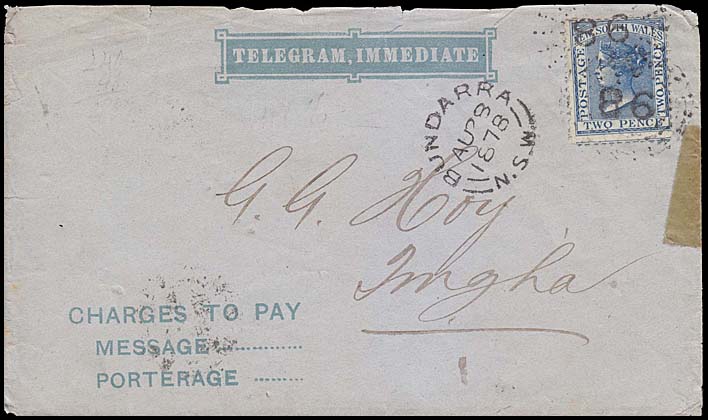
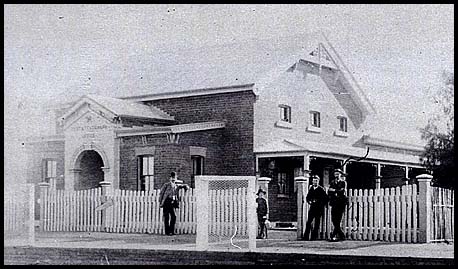 Cobar Post & Telegraph Office (circa 1890).
Cobar Post & Telegraph Office (circa 1890).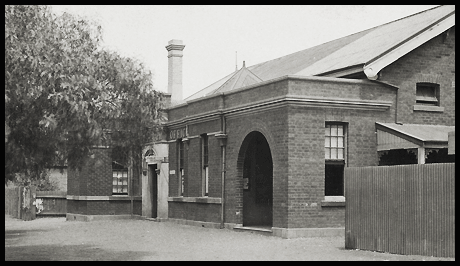 Cobar Post & Telegraph Office (side view).
Cobar Post & Telegraph Office (side view).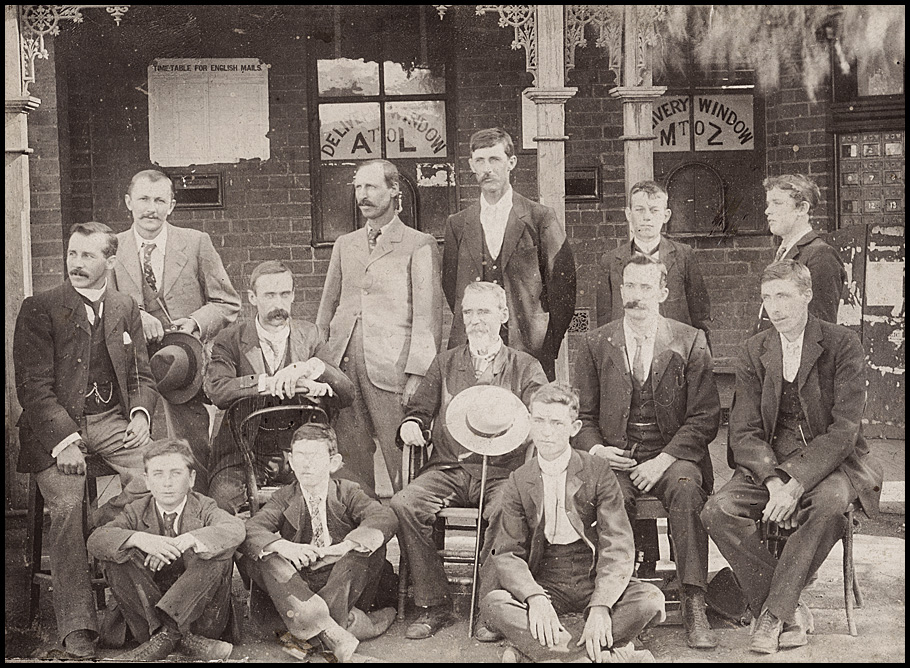
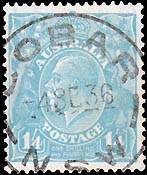
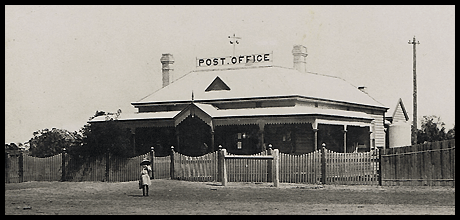
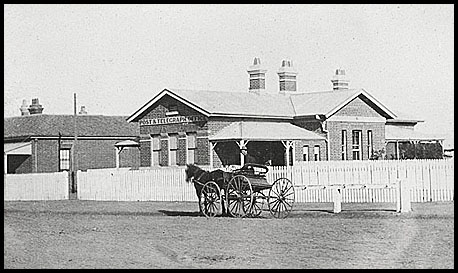


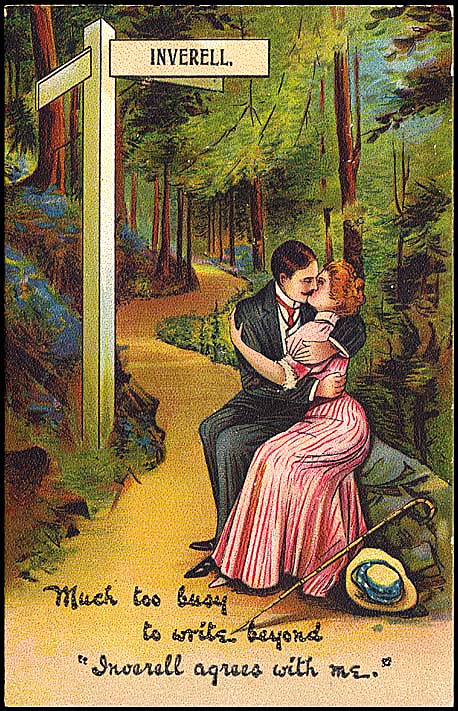
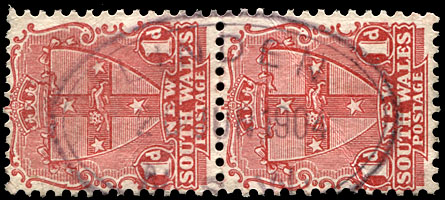

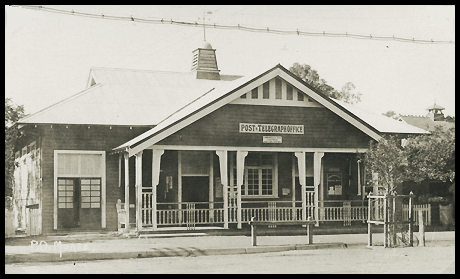
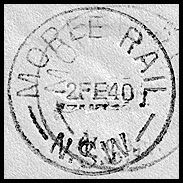


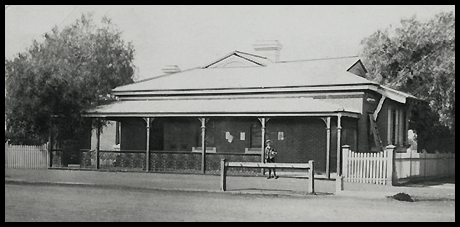 Nyngan Post Office (circa 1900).
Nyngan Post Office (circa 1900).
